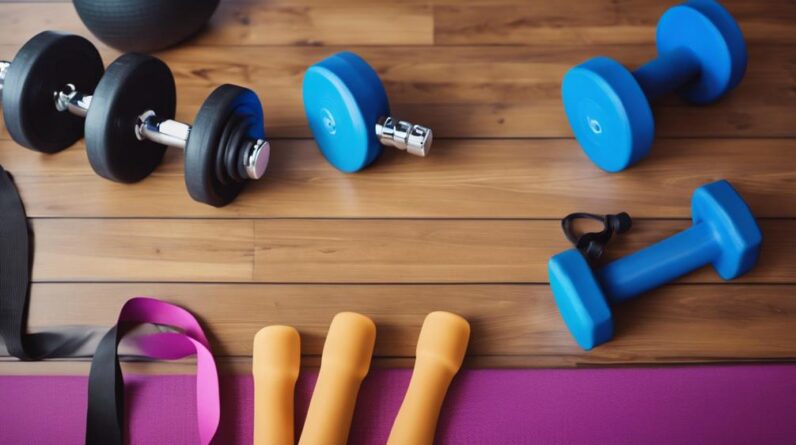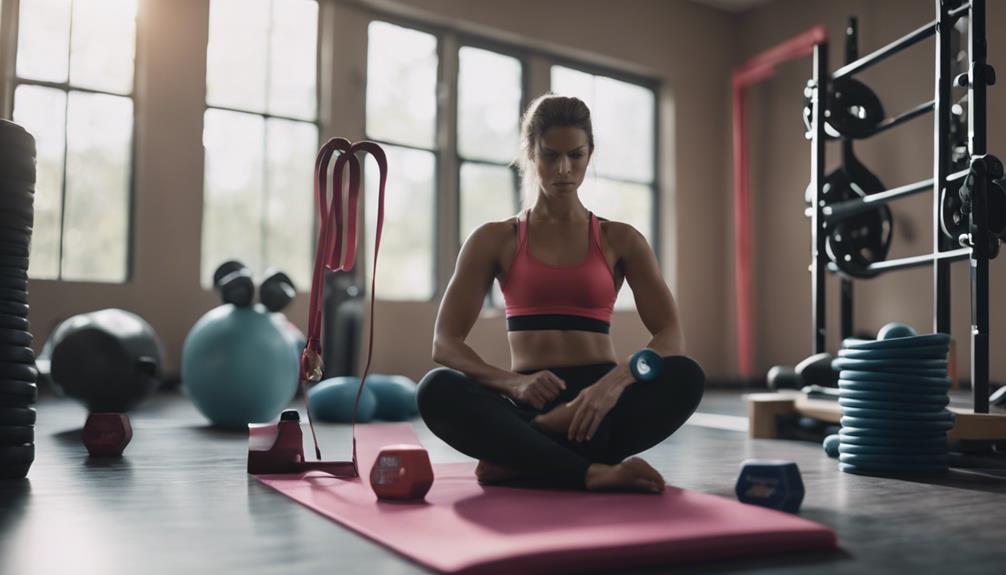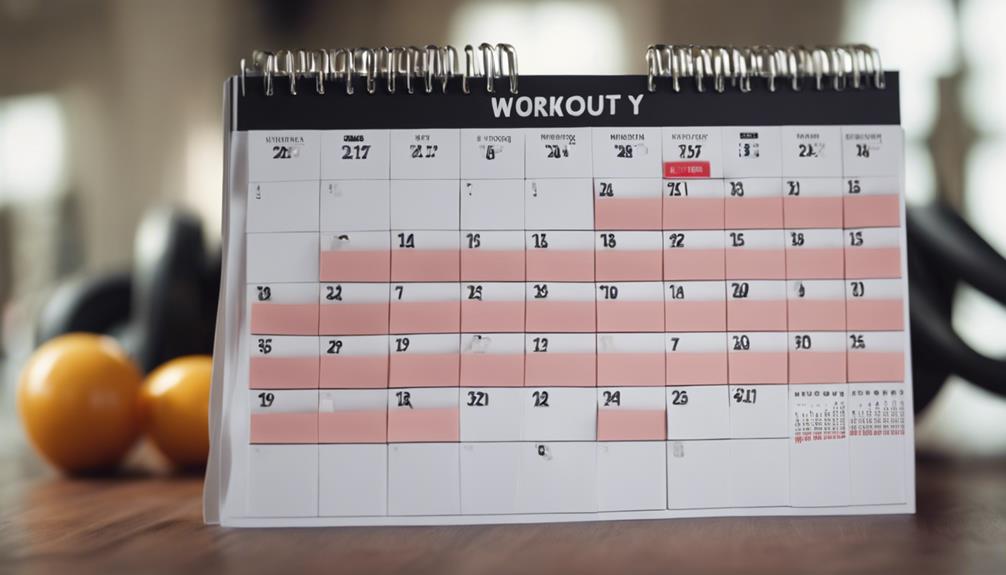
When it comes to crafting a personalized workout routine, assessing your fitness level and defining your fitness goals are crucial starting points.
But what about the next steps, the nitty-gritty details that truly make your routine yours?
There are specific considerations that can elevate your workouts and make them more effective in achieving your goals.
By honing in on these aspects, you can tailor a regimen that not only fits your lifestyle but also maximizes your fitness journey.
Key Takeaways
- Tailor workouts to fit preferences and goals for personalized fitness success.
- Track progress, set achievable goals, and celebrate milestones for motivation.
- Include variety in exercises, intensity, and goals to prevent plateaus and maintain progress.
- Regularly assess and adjust routines to match evolving fitness levels and maximize gains.
Assess Your Fitness Level
Before you embark on creating your personalized workout routine, it's crucial to accurately assess your current fitness level. Fitness assessments are like maps showing where you're starting from, helping you track progress as you move towards your goals.
Take the time to measure your strength, endurance, flexibility, and overall health. This data will be invaluable in tailoring a routine that suits your current abilities and pushes you just enough to improve.
To start, consider testing your cardiovascular fitness with a brisk walk or jog to see how your heart and lungs respond. Check your strength by trying basic exercises like push-ups or squats. Assess your flexibility by reaching for your toes or trying yoga poses.
These initial assessments will guide you in making personalized modifications to exercises and creating tailored routines that challenge you without causing injury. Remember, understanding where you're now will set you up for success in the future.
Define Your Fitness Goals
When defining your fitness goals, focus on what you want to achieve and how you'll get there through a systematic approach tailored to your needs and aspirations. Here are some steps to help you set and achieve your fitness goals:
- Goal Setting: Clearly define what you want to accomplish, whether it's weight loss, muscle gain, endurance improvement, or overall health enhancement. Setting specific, measurable, achievable, relevant, and time-bound (SMART) goals will keep you focused and motivated.
- Progress Tracking: Monitor your progress regularly by keeping a workout journal, using fitness apps, or taking measurements. Seeing how far you've come can boost your motivation and help you make necessary adjustments to your routine.
- Customization: Tailor your workout plan to suit your preferences, fitness level, and schedule. Personalizing your routine will make it more enjoyable and sustainable in the long run.
- Motivation Techniques: Stay motivated by rewarding yourself for reaching milestones, finding a workout buddy, or trying new activities to keep things exciting and challenging.
Determine Your Workout Preferences
To create a personalized workout routine that suits you best, it is essential to determine your workout preferences based on what activities you enjoy and what motivates you to stay active. Remember, your fitness journey should be enjoyable and tailored to your likes and dislikes. Exploring new and fun exercises can keep your routine exciting and engaging. Consider activities like dance classes, hiking, or kickboxing to spice things up. Customizing your routine to your preferences will help you stay committed and eager to work out.
| Workout Preferences | Examples |
|---|---|
| Morning or Evening | *Morning:* Yoga, *Evening:* Running |
| Solo or Group Workouts | *Solo:* Swimming, *Group:* Zumba |
| Indoor or Outdoor | *Indoor:* Weightlifting, *Outdoor:* Cycling |
Choose Suitable Exercise Types
Consider incorporating a variety of exercise types into your routine to target different muscle groups and keep your workouts dynamic and effective. Here are some tips to help you choose suitable exercise types tailored to your preferences and fitness levels for a customized plan:
- Cardiovascular Workouts: Choose from running, cycling, dancing, or swimming to improve your heart health and boost endurance.
- Strength Training: Incorporate weightlifting, bodyweight exercises, or resistance bands to build muscle strength and tone your body.
- Flexibility and Mobility Exercises: Include yoga, Pilates, or stretching routines to enhance flexibility, improve posture, and prevent injuries.
- High-Intensity Interval Training (HIIT): Add bursts of intense exercise followed by rest periods to burn calories, increase metabolism, and improve overall fitness levels.
Set Realistic Timelines
Establishing realistic timelines for your fitness goals is crucial to ensure steady progress and long-term success in your workout routine. By setting achievable milestones, you not only track your progress but also give yourself a constant motivation boost. It's essential to have realistic expectations and understand that fitness is a journey, not a sprint.
When creating your personalized workout routine, consider your current fitness level and lifestyle commitments. This will help you set timelines that are challenging yet attainable. Remember, slow progress is still progress, and every step counts towards your long-term success.
To maintain motivation, break down your ultimate goal into smaller, measurable targets. Celebrate each milestone reached, whether it's running an extra mile or lifting heavier weights. Progress tracking isn't just about numbers; it's about recognizing how far you've come and staying committed to your fitness journey.
Design a Weekly Schedule
When structuring your personalized workout routine, crafting a weekly schedule plays a vital role in maintaining consistency and progress towards your fitness goals. Here are some key tips to help you design an effective weekly workout plan:
- Include Rest Days: Make sure to schedule rest days in your weekly routine to allow your body to recover and prevent burnout. Rest is crucial for muscle repair and overall well-being.
- Incorporate Recovery Methods: Utilize recovery techniques such as stretching, foam rolling, and adequate sleep to help your body recover faster and perform better in subsequent workouts.
- Try Cross Training: Incorporate different forms of exercise like swimming, cycling, or yoga to prevent boredom, work different muscle groups, and reduce the risk of overuse injuries.
- Vary Your Workouts: Keep things interesting by incorporating workout variations like HIIT, strength training, and flexibility exercises to challenge your body in different ways and avoid plateaus.
Designing a well-balanced weekly schedule that includes rest, recovery, cross-training, and workout variations won't only keep you motivated but also help you achieve your fitness goals effectively.
Select Appropriate Intensity Levels
To optimize your workout routine effectively, ensure the intensity levels you select align with your fitness goals and current physical capabilities. Tailoring the intensity of your workouts to your individual needs is crucial for progress and preventing burnout. By incorporating intensity variations and taking a personalized approach, you can keep your workouts engaging and challenging. Remember, it's not about comparing yourself to others but focusing on your own journey and growth.
Intensity Levels Table
| Intensity Level | Description | Benefits |
|---|---|---|
| Low | Comfortable pace, minimal challenge | Ideal for recovery and light movement |
| Moderate | Noticeable effort, slightly challenging | Builds endurance and aids in fat loss |
| High | Intense effort, very challenging | Increases cardiovascular fitness and strength |
| Very High | Maximum effort, extremely challenging | Enhances speed, power, and overall performance |
| Variable | Adjust intensity based on progress tracking | Allows for intensity adjustments and growth |
Incorporate Strength Training
For a well-rounded fitness routine that boosts your overall health and performance, integrating strength training is essential. Here are some key points to consider when incorporating strength training into your workout regimen:
- Strength Training Benefits: Engaging in strength training not only helps you build muscle and increase strength but also improves bone density, boosts metabolism, and enhances overall functional fitness.
- Proper Form Techniques: Focus on maintaining proper form during each exercise to maximize results and prevent injuries. Ensure your body alignment is correct, keep your core engaged, and use a full range of motion for each movement.
- Progressive Overload: Continuously challenge your muscles by gradually increasing the weight or resistance you're using. This progression is crucial for continued strength gains.
- Rest and Recovery: Allow your muscles time to recover between strength training sessions. Adequate rest is essential for muscle repair and growth, so listen to your body and incorporate rest days into your routine for optimal results.
Include Cardiovascular Workouts
To further enhance your fitness regimen, consider incorporating cardiovascular workouts to boost your cardiovascular health and endurance.
Cardiovascular exercises like HIIT workouts, outdoor running, cycling, and jump rope exercises are excellent choices to elevate your heart rate and burn calories effectively. HIIT workouts, known for their intense bursts of activity followed by short rest periods, are a time-efficient way to improve your cardiovascular fitness.
Outdoor running not only challenges your body but also offers a refreshing change of scenery. Cycling is a low-impact exercise that strengthens your lower body while providing a great cardiovascular workout. Jump rope exercises are fun, portable, and can be done virtually anywhere, making them a versatile option to get your heart pumping.
Incorporating these cardiovascular workouts into your routine won't only improve your overall fitness level but also enhance your endurance, helping you reach your fitness goals faster. So, lace-up your shoes, grab your bike, or jump into a HIIT session to elevate your workout routine and boost your cardiovascular health.
Add Flexibility and Mobility Exercises
Enhance your workout routine by incorporating flexibility and mobility exercises to improve your overall fitness level and prevent injury. Flexibility progression and mobility variations are key components to ensure your muscles remain supple and your joints move freely.
Here are some tips to enhance your flexibility and mobility:
- Dynamic Stretching: Perform movements such as leg swings or arm circles to warm up your muscles and increase their range of motion.
- Static Stretching: Hold stretches for 15-30 seconds to improve flexibility and reduce muscle tightness.
- Joint Mobility Exercises: Include exercises like shoulder circles or hip rotations to maintain the health and function of your joints.
- Foam Rolling: Use a foam roller to release muscle tension and improve circulation, aiding in better mobility and flexibility.
Incorporating these stretching techniques and joint mobility exercises into your routine won't only enhance your performance but also help prevent injuries, keeping you active and unrestricted in your fitness journey.
Track Your Progress Regularly
Improve your workout routine effectiveness by regularly tracking your progress to ensure you're on the right path towards your fitness goals. Progress tracking isn't just about numbers; it's a powerful tool that can provide a significant motivation boost. By monitoring improvements, you can see how far you've come and stay inspired to keep pushing forward. Set specific, measurable goals for yourself, whether it's increasing the weight you lift, running faster, or improving your endurance.
Create a workout journal or use apps to log your sessions, exercises, weights, and reps. Seeing your progress laid out in front of you can be extremely motivating. Celebrate your achievements, no matter how small they may seem. Every step forward is a step closer to your ultimate goal. If you notice areas where you're not progressing as you'd like, adjust your routine accordingly. Remember, progress isn't always linear, but by tracking it consistently, you'll have a clear roadmap to success.
Stay committed, stay focused, and watch yourself transform into the best version of you.
Adjust and Evolve Your Routine
Elevate your workout routine by consistently adapting and advancing it to match your evolving fitness level and goals. To keep your workouts effective and exciting, follow these steps:
- Progress Evaluation: Regularly assess your progress by tracking key metrics like strength gains, endurance levels, and body composition changes.
- Workout Modifications: Make necessary adjustments to your routine based on your progress evaluation. Increase weights, try new exercises, or tweak your rep and set ranges to keep challenging your body.
- Goal Achievement: Celebrate your successes along the way to reaching your ultimate fitness goals. Recognize and reward yourself for hitting milestones and making improvements.
- Routine Adjustments: As you get stronger and fitter, don't be afraid to evolve your routine. Gradually increase the intensity, incorporate new training techniques, or add variety to prevent plateaus and keep making gains. Stay committed, stay consistent, and watch yourself transform into the best version of you.
Frequently Asked Questions
How Can I Ensure My Personalized Workout Routine Is Sustainable in the Long Term?
To ensure your personalized workout routine is sustainable in the long term, remember the importance of rest and recovery strategies. Set realistic goals, track progress, and listen to your body. Consistency and balance are key for lasting success.
Are There Any Specific Dietary Recommendations to Complement My Workout Routine?
Looking to fuel your workouts effectively? Ensure you consume adequate protein sources for muscle repair and growth. Hydration is key for performance, while timing your meals around workouts can optimize energy levels. Consider supplements for support.
What Should I Do if I Experience Muscle Soreness or Injuries While Following My Routine?
If you experience muscle soreness or injuries during your routine, focus on recovery strategies like rest, ice, and gentle stretching. Make modifications to prevent overtraining, listen to your body, and incorporate adequate rest periods for healing.
How Can I Stay Motivated and Consistent With My Workouts?
Feeling a bit unmotivated with your workouts? Remember, setting clear goals and adding variety to your exercises can keep you on track. Find what excites you, create a routine that resonates, and stay consistent!
Is It Necessary to Consult With a Fitness Professional Before Starting a Personalized Workout Routine?
Consulting with a fitness professional before starting a personalized workout routine has immense benefits. A fitness assessment guides tailored plans, ensuring safety and effectiveness. Empower yourself by seeking expert advice to maximize your fitness journey.
Conclusion
Now that you have the keys to creating a personalized workout routine, you're ready to unlock your full potential and reach your fitness goals.
Like a sculptor shaping a masterpiece, mold your routine to fit your unique needs and preferences. Stay committed, stay focused, and watch as your hard work transforms you into the best version of yourself.
Embrace the journey, make it your own, and enjoy the incredible results that will follow. You've got this!








